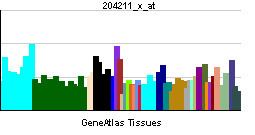EC number 2.7.10.2 | Entrez 5610 | |
 | ||
Aliases EIF2AK2, EIF2AK1, PKR, PPP1R83, PRKR, eukaryotic translation initiation factor 2 alpha kinase 2 External IDs OMIM: 176871 MGI: 1353449 HomoloGene: 48134 GeneCards: EIF2AK2 | ||
Protein kinase RNA-activated also known as protein kinase R (PKR), interferon-induced, double-stranded RNA-activated protein kinase, or eukaryotic translation initiation factor 2-alpha kinase 2 (EIF2AK2) is an enzyme that in humans is encoded by the EIF2AK2 gene.
Contents
- Mechanism of action
- PKR stress pathway
- Viral defense
- Memory and learning
- Fetal alcohol syndrome
- Interactions
- References
PKR protects against viral infections.
Mechanism of action
Protein kinase-R is activated by double-stranded RNA (dsRNA), introduced to the cells by a viral infection. PKR can also be activated by the protein PACT or by heparin. PKR contains an N-terminal dsRNA binding domain (dsRBD) and a C-terminal kinase domain, that gives it pro-apoptotic (cell-killing) functions. The dsRBD consists of two tandem copies of a conserved double stranded RNA binding motif, dsRBM1 and dsRBM2. PKR is induced by interferon in a latent state. Binding to dsRNA is believed to activate PKR by inducing dimerization and subsequent auto-phosphorylation reactions. In situations of viral infection, the dsRNA created by viral replication and gene expression binds to the N-terminal domain, activating the protein. Once active, PKR is able to phosphorylate the eukaryotic translation initiation factor eIF2α. This inhibits further cellular mRNA translation, thereby preventing viral protein synthesis. Since ElF2α is involved in the commonly initiation translation from an AUG codon, the alternative non-AUG initiation takes place instead. An example of mRNAs using non-AUG initiation are mRNAs for the heat shock proteins. Active PKR is also able to mediate the activation of the transcription factor NFkB, by phosphorylating its inhibitory subunit, IkB. Activated NFkB upregulates the expression of Interferon cytokines, which work to spread the antiviral signal locally. Active PKR is also able to activate tumor suppressor PP2A which regulates the cell cycle and the metabolism. Through complex mechanisms, active PKR is also able to induce cellular apoptosis, to prevent further viral spread.
PKR stress pathway
PKR is in the center of cellular response to different stress signals such as pathogens, lack of nutrients, cytokines, irradiation, mechanical stress, or ER stress. PKR pathway leads to stress response through activation of other stress pathway such as JNK, p38, NFkB, PP2A and phosphorylation of eIF2α. ER stress caused by excess of unfolded proteins leads to inflammatory responses. PKR contributes to this response by interacting with several inflammatory kinases such as IKK, JNK, ElF2α, insulin receptor and others. This metabolically activated inflammatory complex is called metabolic inflammasome or metaflammasome.
Viral defense
Viruses have developed many mechanisms to counteract the PKR mechanism. It may be done by Decoy dsRNA, degradation, hiding of virus dsRNA, dimerization block, dephosphorylation of substrate or by a pseudosubstrate.
For instance, Epstein-Barr Virus (EBV) uses the gene EBER-1 to produce decoy dsRNA. This leads to cancers such as Burkitt's lymphoma, Hodgkin's Disease, nasopharyngeal carcinoma and various leukemias.
Memory and learning
PKR knockout mice or inhibition of PKR in mice enhances memory and learning.
Fetal alcohol syndrome
PKR also mediates ethanol-induced protein synthesis inhibition and apoptosis which is linked to fetal alcohol syndrome.
Interactions
Protein kinase R has been shown to interact with:
